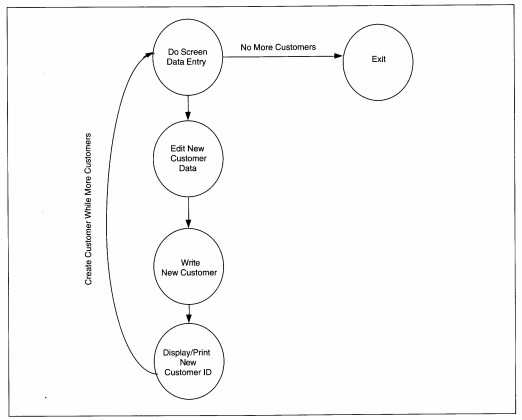Testing Strategies
In this section, you will learn about two kinds of testing strategies: how the logic is tested (via black-box and white-box testing) and how the testing is conducted (by top-down and
bottom-up testing).
White-Box Testing
White-box testing evaluates specific execute item logic to guarantee its proper functioning. Three types of white-box techniques are discussed here: logic tests, mathematical proofs, and cleanroom testing. Logic coverage can be at the level of statements, decisions, conditions, or multiple conditions. In addition, for mathematically specified programs, such as predicate logic used in artificial intelligence applications, theorem proof tests can be conducted. The newest development in white-box strategies is the 'clean room' approach developed by IBM.
Logic Tests
Logic tests can be detailed to the statement level. While execution of every statement is a laudable goal, it may not test all conditions through a program. For instance, an if statement tested once tests either success or failure of the if. At least
two tests are required to test both conditions. Trying to test all conditions of all statements is simply not practical. In a small module with 10 iterations through a four-path loop, about 5.5 million test cases would be needed to try all possible
combinations of paths (i.e., 410 + 49 + 48 .•• + 41 ). Obviously, some other method of deciding test cases is needed. The other white-box logic testing strategies offer some alternatives.

FIGURE 17-8 Cause-Effect Graph for Customer Create
Decision logic tests look at each decision in a module and generate test data to create all possible outcomes. The problem is that decisions are not always discrete and providing for compound decisions requires a different strategy. A problem with logic tests at this level is that they do not test module conformance to specifications. If the test is developed based on the specification, but the specification is interpreted differently by the programmer (for better or worse), the test is sure to fail. The solution to this issue is to require program specifications to detail all logic. While this may be practical for first- and second-generation languages (i.e., machine and assembler languages), it defeats the purpose of higher level, declarative languages.
Condition logic tests are designed such that each condition that can result from a decision is exercised at least once. In addition, multiple entry conditions are tested. Thus, condition tests are more inclusive than decision logic tests. They still suffer
from the problem of ignoring compound decision logic.
Multicondition tests generate each outcome of multiple decision criteria and multiple entry points to a module. These tests require analysis to define multicriteria decision boundaries. If the boundaries are incorrectly defined, the test is ineffective.
When designed properly, multicondition logic tests can minimize the number of test cases while examining a large number of conditions in the case. The use of this technique requires practice and skill but can be mentally stimulating and even fun.
Mathematical Proof Tests
When evaluating logic, the goal is zero defects. One method of approaching zero defects is to apply mathematical reasoning to the logic requirements, proving the correctness of the program. This method requires specifications to be stated in a formal
language such as the Vienna Development Method (VDM). Formal languages require both mathematical and logic skills that are beyond the average business SE's ability at the present time. An example of a general process overview for a payroll system
as specified in VDM is shown as Figure 17-9. While a detailed discussion of these methods is beyond the scope of this text, they deserve mention because they are the only known way for attaining zero defects and knowing it.
Cleanroom Tests
Cleanroom testing is an extension of mathematical proof that deserves some comment. Cleanroom testing is a manual verification technique used as a part of cleanroom development. The theory of cleanroom development is that by preventing errors from ever
entering the process, costs are reduced, software reliability is increased, and the zero defect goal is attained. The process was introduced in IBM in the early 1980s by Mills, Dyer, and Linger, and applies hardware engineering techniques to software.
Formal specifications are incrementally developed and manually verified by walk-through and inspections teams. Any program that is not easily read is rewritten. All program development is on paper until all verification is complete.
Cleanroom testing techniques are walk-throughs and formal mathematical verification. The goal is to decompose every module into functions and their linkages. Functional verification uses mathematical techniques, and linkage verification uses set theory whenever possible to prove the application design and code.
After verification, an independent testing team compiles and executes the code. Test data is compiled by analysis of the functional specification and is designed to represent statistical proportions of data expected to be processed by the live system.
In addition to normal data, every type of catastrophic error is produced to test that the application does degrade gracefully.
The success of cleanroom development and testing is such that more than 80% of reported projects have an average failure time of less than once every 500 software years. Software years are counted by number of sites times number of years of operation. For example, 100 sites for one year is 100 software years. This is an impressive statistic that, coupled with the 80-20 rule, can guide redevelopment of error-prone modules. The 80-20 rule says that 80% of errors are in 20% of modules. If those modules can be identified, they should be redesigned and rewritten. Modules for redevelopment are more easily identified using cleanroom techniques than other techniques. The disadvantages of cleanroom development are similar to those of mathematical proof. Skills required are beyond those of the average business SE, including math, statistics, logic, and formal specification language. We will say more about the 80-20 rule later.